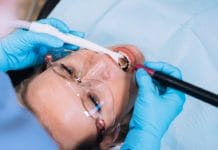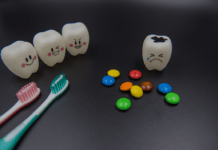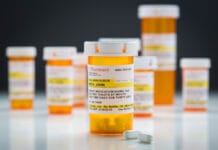Sixty years ago, Nobel prize-winning physicist Richard P. Feynman made a speech to the American Physical Society concerning manufacturing at the dimension of atoms and molecules. He spoke about the many inventive possibilities that may follow and encouraged the creation of methods for measurement and manufacturing at nanoscale levels.
That speech was the beginning of nanoscience and nanotechnology. Since then, nanoscience has grown rapidly, expanding into many different applications and consumer products. Realized or not, dental hygienists work with nanoparticles daily in clinical practice, and many of the products recommended to patients contain them.
Nanotechnology allows almost complete control of the structure of matter at nanoscale dimensions due to the ability to manipulate materials at that level directly.4 Atoms and molecules can be arranged as needed one-by-one to create a new functional structure. The physical, chemical, and biological properties of a structure may completely change depending on the size and surface area of the resulting nanoparticle.3
Nanotechnology often creates more useful properties, including being lighter, stronger, and more durable. These materials may also have enhanced electrical conductivity, enhanced chemical reactivity, and different melting points than their micro-sized and macro-sized counterparts.
A nanoparticle has at least one dimension measuring 1-100 nanometers. A nanometer is a unit of length that measures 1 billionth of a meter. For scale, a human hair measures 100,000 nanometers thick.4
Where Nanoparticles are Found
Nanoparticles have many applications with enhanced detection in dental diagnosis, new structural materials, and targeted therapeutic agents.2 Filling materials, implant surface coatings and placement, periodontal surgery, caries prevention, teeth whitening, and anti-sensitivity are just a few aspects of dentistry already using nanoparticles.5
The most commonly used nanoparticles in dentistry are silver, carbon, and iron oxides. Hydroxyapatite (HAp), zirconia, silica, and titania (Ti02) are also found in many products and prosthetic materials.5 There are several ways dental hygienists may encounter nanoparticles:
- Nanomaterials for periodontal drug therapy is a drug delivery system using a matrix that is placed into periodontal pockets and releases triclosan or tetracycline as it biodegrades. This allows targeted drug therapy that releases loaded drugs in increments.1,4
- Teeth whitening products are incorporating nanoparticle calcium peroxide due to its ability to penetrate deeper into the tooth structure, stay in contact with the tooth surface longer, and increase product effectiveness.1
- Nanocomposite artificial teeth are more durable than acrylic or micro-fill composite teeth. They have superior color and higher resistance to abrasion.4 In addition, nanoparticle chlorhexidine coatings or integration into nanocomposite material may help maintain oral health and avoid fungal infections partially and fully edentulous patients.5
- Dental digital imaging sensors are replacing scintillators (the layer that absorbs x-rays) with nanophosphor scintillators that essentially diminish the radiation dose while producing high-quality images.4
- Biosensors, such as those used in oral cancer detection, use a biologically active element with a physical transducer to generate a measurable signal proportional to the concentration of a chemical species in any sample. Nano-biosensors elevate the ability to diagnose oral cancer with better accuracy. They rapidly identify targeted biological tissues at an ultralow molecular level finding cancer cells at an early stage and low concentrations.1
Oral care products containing nanoparticles have become widely popular in recent years, but are not really new. Nanoparticles may be found on toothbrush bristles, in toothpaste, mouthwash, and fluoride gels. It is believed that since inorganic enamel building blocks range from 20 to 40 nanometers in size, the response to nanoparticles is better than micro or macro scale particles of the same ingredients, yielding better results for patients.1
- Nanoparticle toothbrushes generally contain nanogold or nanosilver properties on their bristles to add antibacterial effect and improve mechanical plaque removal.1
- Different brands of toothpaste are using a variety of nanoparticles including calcium carbonate, trimetaphosphate, carbonate apatite, and hydroxyapatite. These nanoparticles have properties that reduce caries activity, reduce dentinal sensitivity, promote remineralization of early carious lesions, and protect teeth from erosive demineralization.1,4,5
- Mouthwashes include nanoparticles that have bacteriostatic effects on mutans like silver, zinc oxide, and gold. Of those three, silver has the greatest antimicrobial effect in lower concentrations with lower toxicity.4
The effects of nanomaterials are size dependent; A 100-nanometer particle may become toxic as the size is reduced and vice versa.1 Due to their size, nanoparticles can be inhaled and cross cell membranes. Right now, there is little to no information on the environmental effects of nanomaterials or enough research to predict how the human body and immune system may be affected long term by nanoparticle exposure.1
Developing a multiagency regulatory framework can be a legislative maze. The CDC, NIOSH, EPA, and several other regulatory agencies are currently working on research to fully assess the effects of nanotechnology.1,3 There are no labeling standards yet to identify products containing nanomaterials. The Project on Emerging Nanotechnologies provides the most comprehensive inventory of over a thousand products containing nanoparticles that are available to the public.
Exciting Possibilities for the Future
There is excitement for what is next in nanotechnology, which is somewhat seen as the next scientific evolution. The Foresight Institute offers a $250,000 Feynman Grand Prize to the first researcher to create a functional nanoscale robotic arm and nanoscale computing device.2
As recently as April 2019, a group of researchers at the University of Pennsylvania School of Dentistry created microbots that Dr. Feynman only dreamed of. Microbiologists used iron oxide-containing nanoparticles that work catalytically to activate hydrogen peroxide to release free radicals that can kill bacteria and destroy biofilms in a targeted fashion.7 Clinician-scientists combined the nanoparticles with a robotic platform from the engineering department that used similar iron oxide nanoparticles as a base for microrobots. The results were two robotic catalytic antimicrobial robots (CARs), one for surfaces and one for confined spaces.7 These microbots disrupted and removed bacterial biofilm from even the hardest to reach areas of tooth structure.
Imagine a future where dental hygienists may be guiding these microbots around teeth with a magnetic field instead of using scalers and ultrasonic devices, or periodontal ligament regeneration through tissue engineering. Imagine toothpastes and mouthwashes that leave behind “dentifrobots” to continuously prevent plaque and calculus accumulation.4 The possibilities seem endless.
Before you leave, check out the Today’s RDH self-study CE courses. All courses are peer-reviewed and non-sponsored to focus solely on high-quality education. Click here now.
Listen to the Today’s RDH Dental Hygiene Podcast Below:
References
- Alkahtani, R.N. (2018). The implications and applications of nanotechnology in dentistry: A review. The Saudi Dental Journal,30(2), 107-116. Retrieved May 3, 2019, from https://www.sciencedirect.com/science/article/pii/S1013905218300038.
- Bhardwaj, A., Bhardwaj, A., Misuriya, A., Maroli, S., Manjula, S., Singh, A.K. (2014). Nanotechnology in dentistry: Present and future. Journal of international oral health: JIOH, 6(1), 121–126.
- Castranova, V., Hoover, M.D., Hunt, W.D., Kulinowski, K., Schulte, P.A., Tinkle, S. (2010). Global Efforts to Prevent Occupational and Environmental Hazards from Nanotechnology [PDF]. CDC.
- Ozak, S.T., Ozkan, P. (2013). Nanotechnology and dentistry. European journal of dentistry, 7(1), 145–151.
- Priyadarsini, S., Mukherjee, S., Mishra, M. (2017). Nanoparticles used in dentistry: A review. Journal of oral biology and craniofacial research, 8(1), 58–67. doi:10.1016/j.jobcr.2017.12.004
- Varner, K.E., El-Badawy A., Feldhake D., Venkatapathy R. (2010) State-Of-The-Science Review: Everything NanoSilver and More. U.S. Environmental Protection Agency, Washington, DC, EPA/600/R-10/084, 2010.
- https://www.dental-tribune.com/news/researchers-develop-microrobots-to-break-up-plaque/











